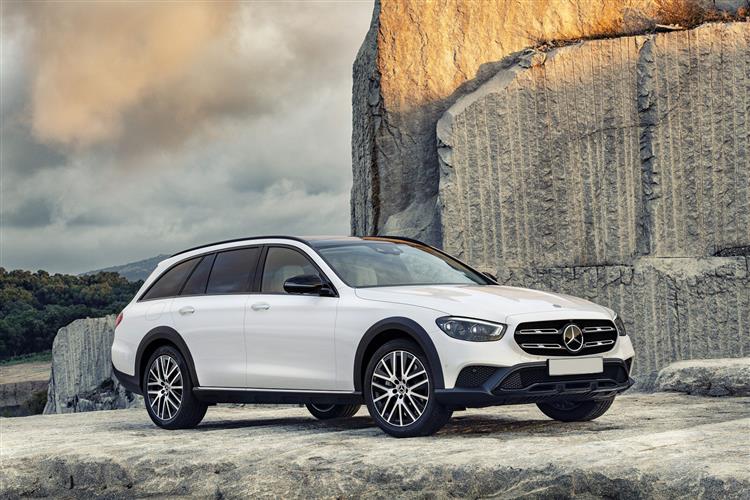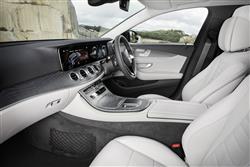How will you view?
This is a sample, showing 30 seconds of each section.
PREMIUM ESTATEMENT OF PRACTICALITY (some text hidden) SECTIONED_new_mercedeseclassestate_2021
By Jonathan Crouch
Introductionword count: 96
The Mercedes E-Class Estate has always been a very classy way to carry rather a lot. The updated version of the fifth generation 'W213' model, introduced in 2020, became cleverer and more efficient than ever. A focus on downsized engines was a big draw for original customers. There was a frugal base diesel, a plug-in hybrid and, at the top of the range, fire-breathing Mercedes-AMG models to add some excitement. Overall, the whole range in this post-2020-era form just felt slicker and more desirable. It's all very impressive, particularly as you can carry up to 1,820-litres.
Modelsword count: 26
5dr Estate (2.0 diesel [E220d] / 3.0 diesel [E300d/E300 de/E400d] / 2.0 petrol [E200] / 3.0 petrol [E400/E 53 AMG] / 4.0 petrol [E 63 AMG])
Historyword count: 195
It used to be that if you wanted a large, plush practical estate, you bought a big Volvo. For some years now though, that role has been only fully filled by the Mercedes E-Class Estate. Rivals trade space for a bit of style, but in W213 form this car continued to prioritise practicality, with 640-litres of room on offer even before you start folding seats. This 'W213'-series design was actually the fifth generation version to be badged 'E-Class' and was originally introduced in 2017, but here, we're looking at the facelifted model introduced in 2020. It does of course enjoy all the advantages developed for its saloon counterpart, a car offering efficient engines, astonishing technology and luxurious comfort. As part of the facelift, this W213 design gained a smarter look and quite a bit of extra technology to keep it current in the face of the various fresh or updated rivals introduced since the original launch. There were also cutting-edge driver assistance features that allowed owners to take a step closer to fully autonomous driving. The 'W213'-series E-Class Estate range sold until mid-2023, after which a new sixth generation version of this model was launched.
What You Getword count: 808
One of the defining aspects of automotive design lies in creating styling characters so brand-specific that badges are hardly needed. This 'W213'-series E-Class Estate model always delivered that; it could only be a Mercedes. But what kind of Mercedes? The styling updates added to this design actually positioned this station wagon body style visually closer to the next model down in the range, the 'W206'-series C-Class Estate. This remained though, a stylish piece of penmanship, the boxy powerfully-extended silhouette characterised by short overhangs, a long wheelbase, large wheels and taut, well-defined flanks. Broad shoulders sit above the wheel arches and the profile is defined by a powerful waist-level swage line that flows from front to rear through the door handles, while a further crease lower down sits above a distinct sill line to give the flanks some shape. This Estate version added 10mm of length over the alternative E-Class saloon and both body styles in this revised form gained revised aero-influenced wheels, rims ranging from 17 to 20-inches in size. We should get to the update changes made as part of this mid-term facelift. There were certainly quite a few of them, as owners of earlier pre-2020-era 'W213'-series E-Class Estate models will note at the front. The swept-back power domed bonnet flows down into a grille that was turned upside down, in this revised form being wider at the bottom than the top; a little disappointingly, it was now no longer possible to have it with an upstanding bonnet ornament. The LED headlights flanking the grille were different too - and, in pricier 'AMG Line'-series variants featured Mercedes' MULTIBEAM tech with 84 individually controlled LEDs and integrated daytime running lamps. These top models also gained a bumper closer to the more assertive style of that used by the Mercedes-AMG performance versions, which gained more overt corner cut-outs characterised by twin strakes on either side. And inside? Well take a seat up-front and if you're familiar with the original 2017-era version of this 'W213'-series E-Class design, at first glance, there won't seem to be too many improvements over what went before, but delve into the detail and you'll find that quite a lot's different, thanks to the change to the brand's more sophisticated MBUX multimedia system, physically evidenced by the switch to a centre console-mounted touchpad interface. The multimedia colour display that helps to control a pair of bonded 12.3-inch monitors was standard across the range and could also be activated by touchscreen or the provided 'Hey Mercedes' voice-activated functionality. Also improved was the steering wheel, enhanced to be a capacitive touch-sensitive design incorporating a restyle that allows for two separate bars of switchgear to be installed along the two horizontal spokes. The dash and fascia design doesn't have the dramatic, futuristic appeal of the seventh generation S-Class of this period, but at first glance, there's much the same feeling of opulence and quality. Plus the powered, heated leather seats are perfectly contoured and fitted around the driver to give ample comfort during long trips. In the rear, the first thing you find inside is more than ample space - again, no great surprise given this E-Class model's private hire popularity, though head room might be a touch tight for those over 6 foot. If the front passengers have their seats at the lowest setting, you might find room for your feet slightly limited, but otherwise the rear footwells are big and broad, plus there are pronounced knee room cut-outs in the front seat backs. Let's finish with a look at trunk room. The boot gets automatic operation for the tailgate, which rises to reveal a 640-litre space, easily the largest in the segment. It's a square, usefully-shaped area too, with 1,100mm of width between the wheel arches. Which is why this E-Class Estate is just about the only car you could choose that can accommodate a Europallet - though you might think twice about inflicting such a thing onto the immaculate carpets fitted here. In this updated W213 model, there was no longer the option of having a third row seat bench fitted back here though. This revised model's second row rear bench seat gained additional cargo-related functionality, making it possible to position the backrest at an approximately 10-degree steeper angle. This creates an additional 30-litres of cargo volume, while continuing to enable full use to be made of five seats. In addition, 40:20:40-split for the rear backrest, long items like skis can be slid in between two rear-seated passengers. To release the backrests, there are electric switches located in the load compartment and to the right and left next to the backrests. Use these and up to 1,820-litres of fresh air can be freed up. No segment rival can get anywhere close to that figure. Space falls by 170-litres if you opt for a Plug-in hybrid variant.
To see the full road test text contact us on 0330 0020 227
Pictures (high res disabled)

.jpg)
|
.jpg)
|

|
Scoring (subset of scores)
Category: Luxury Saloons and Estates
| Performance | |
| Handling | |
| Comfort | |
| Space | |
| Styling, Build, Value, Equipment, Depreciation, Handling, Insurance and Total scores are available with our full data feed. | |



